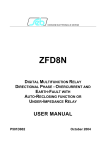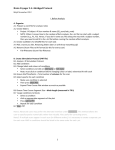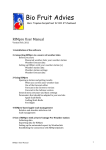Download QUICK USER GUIDE Contents 1. Introduction 1 2. Overview of
Transcript
QUICK USER GUIDE DAGMARA OSZKIEWICZ Contents 1. Introduction 2. Overview of phase functions 2.1. H,G phase function 2.2. H,G1 ,G2 phase function 2.3. H,G12 phase function 3. Numerical methods 3.1. Least Squares 3.2. Error estimation 3.3. Fitting data for individual asteroids 3.4. Fitting data for asteroid families 4. Software description, requirements and dependences 5. Testing the code 6. Running instructions 6.1. Processing single asteroid phase curve data 6.2. Processing multiple asteroids at the same time 7. Processing big amount of data 8. Example input file 9. Example results 10. Comments 11. Acknowledgments References 1 1 2 3 4 4 4 5 6 6 6 7 8 8 8 10 11 13 13 13 14 1. Introduction 2. Overview of phase functions Absolute magnitude computation relies on magnitude phase-curve fitting. A number of different mathematical formulations for magnitude phase curves have been developed. Here we make use of the H,G phase function, the H,G1 ,G2 phase function, and the H,G12 phase function. Date: February 17, 2011. 1 2 DAGMARA OSZKIEWICZ The H,G phase function was developed to predict the magnitude of an asteroid as a function of solar phase angle [Bowell et al. (1989)]. This function was adopted by the International Astronomical Union in 1985 to redefine the absolute magnitudes of asteroids. The H,G phase function is not valid for phase angles greater than 120◦ . The H,G1 ,G2 and H,G12 phase functions [K. Muinonen et al. (2010)] are based on cubic splines. The H,G1 ,G2 phase function is designed to fit asteroid phase curves containing substantial numbers of observations, whereas the H,G12 phase function is applicable to asteroids that have sparse or low-accurancy photometric data. 2.1. H,G phase function. In the H,G magnitude phase function, the reduced apparent magnitudes can be obtained from: 10−0.4V (α) = a1 Φ1 (α) + a2 Φ2 (α) = 10−0.4H [(1 − G)Φ1 (α) + GΦ2 (α)] , (1) where α is the phase angle, V (α) is the reduced magnitude. The basis functions Φ1 , Φ2 are defined as: (2) 0.986 sin α Φ1 (α) = w 1 − 0.119 + 1.341 sin α − 0.754 sin2 α ! 1 + (1 − w) exp(−3.332 tan0.631 α) , 2 ! 0.238 sin α Φ2 (α) = w 1 − 0.119 + 1.341 sin α − 0.754 sin2 α ! 1 + (1 − w) exp − 1.862 tan1.218 α , 2 ! 1 w = exp − 90.56 tan2 α . 2 ! The coefficients a1 and a2 are estimated from observations using linear least squares. The absolute magnitude H and slope parameter G, can then be obtained from: (3) (4) H = −2.5 log10 (a1 + a2 ), G= a2 . a1 + a2 QUICK USER GUIDE 3 2.2. H,G1 ,G2 phase function. The reduced magnitudes V (α) can be obtained from [K. Muinonen et al. (2010)]: 10−0.4V (α) = a1 Φ1 (α) + a2 Φ2 (α) + a3 Φ3 (α) = 10−0.4H [G1 Φ1 (α) + G2 Φ2 (α) + (1 − G1 − G2 )Φ3 (α)] , (5) where the absolute magnitude H and slope parameters G1 , and G2 are: (6) H = −2.5 log10 (a1 + a2 + a3 ), (7) G1 = a1 , a1 + a2 + a3 a2 . a1 + a2 + a3 The coefficients a1 , a2 , a3 are estimated from the observations using linear least squares. The basis functions Φ1 (α), Φ2 (α), Φ3 (α) are defined as: • For 0◦ < α ≤ 7.5◦ : – Φ1 (α) = 1 − π6 α; 9 – Φ2 (α) = 1 − 5π α; – Φ3 (α) is defined using a cubic spline as defined in Table 2. • For 7.5◦ < α ≤ 30◦ : – Φ1 (α) is defined using a cubic spline as defined in Table 1; – Φ2 (α) is defined using a cubic spline as defined in Table 1; – Φ3 (α) is defined using a cubic spline as defined in Table 2. • For 30◦ < α ≤ 150◦ : – Φ1 (α) is defined using a cubic spline as defined in Table 1; – Φ2 (α) is defined using a cubic spline as defined in Table 1; – Φ3 (α) = 0. (8) G2 = α (deg) 7.5 30.0 60.0 90.0 120.0 150.0 Table 1. Φ1 7.5 ×10−1 3.3486016 ×10−1 1.3410560 ×10−1 5.1104756 ×10−2 2.1465687 ×10−2 3.6396989 ×10−3 Knots for splines Φ2 9.25 ×10−1 6.2884169 ×10−1 3.1755495 ×10−1 1.2716367 ×10−1 2.2373903 ×10−2 1.6505689 ×10−4 used in Φ1 and Φ2 . π The first derivatives (per radian) at the ends of splines are: Φ01 ( 24 ) = − π6 , 9 −2 0 π 0 5π −8 = −9.1328612×10 , Φ2 ( 24 ) = − 5π , Φ2 ( 6 ) = −8.6573138×10 , Φ03 (0) = −0.10630097, Φ03 ( π6 ) = 0. Φ01 ( 5π ) 6 4 DAGMARA OSZKIEWICZ α (deg) Φ3 0.0 1 0.3 8.3381185 ×10−1 1.0 5.7735424 ×10−1 2.0 4.2144772 ×10−1 4.0 2.3174230 ×10−1 8.0 1.0348178 ×10−1 12.0 6.1733473 ×10−2 20.0 1.6107006 ×10−2 30.0 0 Table 2. Knots for spline used in Φ3 . 2.3. H,G12 phase function. G1 and G2 from the three-parameter phase function are replaced by a single slope parameter G12 which relates to the G slope parameter in the H,G system (though there is not an exact correspondence). The reduced flux densities can be obtained from [K. Muinonen et al. (2010)]: (9) 10−0.4V (α) = L0 (G1 Φ1 (α) + G2 Φ2 (α) + (1 − G1 − G2 )Φ3 (α)) where: 0.7527G12 + 0.06164, G1 = 0.9529G12 + 0.02162, −0.9612G12 + 0.6270, G2 = −0.6125G12 + 0.5572, if G12 < 0.2; otherwise; if G12 < 0.2; otherwise; (10) H = −2.5 log10 L0 ; (11) and L0 is the disk-integrated brightness at zero phase angle. The basis functions are as in the H,G1 ,G2 magnitude phase function. Coefficients L0 and G12 are estimated from observations using non-linear least squares. 3. Numerical methods 3.1. Least Squares. Least-squares fitting is carried out in the flux-density domain, because it reduces the problem to a linear problem for the H,G1 ,G2 and H,G phase functions, and the errors are symmetric about the fit. The flux for the ith observation is computed using: Li = 10−0.4Vi , (12) (L) σi (V ) = Li (100.4σi − 1), QUICK USER GUIDE 5 (V ) where σi are standard deviations of the magnitude measurements. The χ2 -value to be minimized here with respect to the parameters a is (13) 2 χ (a) = N X [Li − Li (αi , a)]2 (L) [σi ]2 i=1 . The computed disk-integrated brightnesses are expressed via Na basis functions Φ1 (α), Φ2 (α), . . . , ΦNa (α): (14) Li (αi , a) = Na X al Φl (αi ). l=1 For the H,G and H,G1 ,G2 phase functions, the a coefficients are fitted using linear least squares and for the H,G12 phase function the L0 , and G12 parameters are fitted using simplex non-linear regression [J. A. Nelder and R. Mead (1965)]. 3.2. Error estimation. The absolute magnitude computation requires MonteCarlo error estimation because of its nonlinearity. Gaussian errors in parameters a1 , and a2 (in the H, G, phase function) or a1 , a2 , and a3 (in the H,G1 ,G2 phase function) result in non-Gaussian errors in the H,G or H,G1 ,G2 parameters. To estimate those errors, we make use of the least-squares solution for a1 , and a2 or a1 , a2 , and a3 and its error covariance matrix. We set the error covariance matrix and the least-squares solution as a covariance and mean of a multi-normal distribution to produce a sample a1 , a2 or a1 , a2 , a3 using a multi-normal random number generator. The ai samples are then converted to H,G or H,G1 ,G2 samples using either Eqs. 3 and 4 or 6, 7 and 8. Next, the samples are ordered in descending goodness of fit and then 68.27% (equivalent to 1-σ) and 99.73 % (equivalent to 3-σ) error cut-offs are computed, resulting in a list of subsamples. The limiting (maximum and minimum) H,G or H,G1 ,G2 parameters are selected from that list and the two-sided errors are computed. Error estimation for the H,G12 parameters derives from the Markov chain MonteCarlo (MCMC) technique. From non-linear least-squares fitting we obtain the least-squares values of L0 and G12 . The errors in L0 , G12 are non-Gaussian, so the error estimation used for the H,G and H,G1 ,G2 phase functions cannot be used. To proceed, we create one long Markov chain by sampling possible L0 , G12 solutions. The chain is started at the least-squares point for L0 , G12 , and makes use of a multivariate Gaussian proposal distribution, where a covariance matrix for L0 , G12 is taken from the least-squares solution. After obtaining 10, 000 different solutions, the two-sided errors are computed based on the equivalents of the 1-σ and 3-σ cut-offs as in the H,G and H,G1 ,G2 phase functions. Error envelopes are based on the 1-σ and 3-σ Monte Carlo samples. We compute reduced magnitude for all the sampled values of H,G and/or H,G1 ,G2 and/or L0 , G12 for a set of phase angles, and choose the maximum and minimum of reduced magnitude at each phase angle. 6 DAGMARA OSZKIEWICZ 3.3. Fitting data for individual asteroids. We start our computation by performing least-squares fits with all three phase functions, assuming 0.3 mag standard deviation for all of the observations (see section ??). We extract magnitude residual rms value from that computation and repeat least-square fitting assuming magnitude uncertainties equal to the rms value for each phase function. Next, we perform the Monte-Carlo error computation to obtain two-sided errors in the photometric parameters, together with the error envelopes for the phase functions. 3.4. Fitting data for asteroid families. We fit family data sets using the H,G1 ,G2 phase function. Family membership was established by agglomerating asteroids in relative velocity phase space [M.-T. Enga et al. (2011, in prep.)]. Velocity cutoffs for each family are related to the background population velocity. We devise a 20 × 20(400 nodes) grid in G1 , G2 phase space (G1 ∈ (0, 1), G2 ∈ (0, 1)), and step through that grid. In each step, G1 , G2 parameters are fixed to the node G1 , G2 values, and for a number of asteroids in a given family (i = 1, 2, ..., N ) a linear least-squares fit of L0i is performed. Global family χ2 is computed assuming no correlation in the noise among different asteroids. From the 400 nodes we select the one with the best χ2 , and create a new, denser grid in the vicinity of that node (stretching 1-node distance on each side from the best χ2 solution). We repeat the least squares analysis in the nodes of the new grid. This operation is repeated a number of times to obtain improved precision of the G1 , G2 parameters. Once the family G1,f , G2,f have been obtained, we perform Monte-Carlo error analysis in the N + 2 parameters phase space to obtain the two-sided 1-σ and 3-σ uncertainties. 4. Software description, requirements and dependences The Asteroid Phase Function Analyzer is an online, free, interactive applet written in Java. It is cross platform and it runs in a Web browser using a Java Virtual Machine (JVM). It requirers 1.6 Java Runtime Environment (JRE). The core of the applet constitutes a multi-threaded Java program composed of a number of packages, the contents of which are summarized in Table 3. The program uses the Java Scientific Library written by Flanagan []. The program is multi-threaded, and uses a thread pool pattern, in which a number of threads are created (one per computer core) to perform absolute-magnitude computations (one per asteroid) in parallel. Tasks are organized in a queue. As soon as the thread has completed a task, the next task from the queue is requested until all the tasks are completed. The programming details need not be known to applet users. The applet is straightforward and very easy to use. A user guide is also provided. It is, however, expected that the user be familiar with the methods behind state-ofthe-art empirical phase-functions as well as non-Gaussian error estimation. The applet primarily produces absolute magnitudes and slope parameters, together with two-sided uncertainties for all three phase functions at the same time for a QUICK USER GUIDE 7 Package Classes included Content absoluteMagnitude AsteroidData.java Main package, with Thread Pool AsteroidPhotometricSolution.java creating jobs (for different asteroids) AbsoluteMagnitudeand distributing them among cores. CalculatorThreaded.java Contains data object and object ThreadPool.java with collected results. phaseCurves Function1D.java Contains the phase functions HGfunction.java and methods for evaluating HG1G2function.java them for different sets of parameters. HG12function.java regression LinearRegressor.java Contains tools for performing FittedFunctionHG12.java linear and nonlinear least-squares FitterHG.java phase-curve fitting and least-squares FitterHG1G2.java error analysis. FitterHG12.java errorAnalysis NonGaussianErrorEstimator.java Contains methods for MCMCSampler.java two-sided error estimation, RandomNumberGenerator.java a multinormal random number PdfComparator.java generator, a Markov-chain MonteParameterComparator.java Carlo sampler, comparators. PhaseCurveSolution.java inputOutput DataFileReader.java Contains methods dealing OutputWriter.java with input/output. Utils.java ui PhaseCurveAnalyserApplet.java Contains the applet and graphical DataEntry.java user interface. FileInputPane.java InputTableModel.java Task.java ResultPane.java Logger.java TextInputPane.java Table 3. Description of main packages given data file. Other photometric parameters and plots are also produced. The tool is available at http://asteroid.astro.helsinki.fi/AstPhase/. 5. Testing the code We compared the results obtained from this software and those from Fortran software [K. Muinonen et al. (2010)]. We have repeated calculations for all the asteroids listed in Table 4 using the same data and error estimates (that is, ±0.03 8 DAGMARA OSZKIEWICZ mag uncertainty for all the objects except for the Moon, where we assume ±0.023 mag uncertainty for phase angles α < 100◦ , and ±0.2 mag uncertainty for phase angles α ≥ 100◦ ). Tables 5 and 6 contain the results obtained using Java software (I) and Fortran software (II). The results from [K. Muinonen et al. (2010)] and the Asteroid Phase Function Analyzer agree very well. There exist some small differences in the error analysis which can be explained by the limited number of samples in the Monte Carlo simulations. Asteroid Class pV Nobs αmin αmax References (24) Themis C, B 0.08 22 0.34 20.8 [Harris et al. (1989a)] (44) Nysa E 0.54 23 0.17 21.5 [Harris et al. (1989b)] (69) Hesperia M 0.14 21 0.13 16.0 [Poutanen et al. (1985)] (82) Alkmene S 0.21 11 2.29 27.2 [Harris et al. (1984b)] (133) Cyrene SR 0.26 11 0.20 13.2 [Harris et al. (1984a)] (419) Aurelia F 0.05 7 0.62 15.4 [Harris and Young (1988)] (1862) Apollo Q 0.26 18 0.2 89.0 [Harris et al. (1987)] 0.17 17 0.5 140.0 [Bowell et al. (1989)] The Moon Table 4. Objects used to illustrate the Asteroid Phase Function Analyzer capabilities. We show the V -band geometric albedo pv [Tedesco, E.F. at al. (2002a)], the number of observations Nobs , the minimum and maximum phase angles of the observations αmin and αmax , and references to the observations. 6. Running instructions 6.1. Processing single asteroid phase curve data. Go to ”File Input” tab, click ”Load file”, import data file from your file system (data file has to be in format specified below). Once the file is imported click Compute. Go to ”Log” tab to trace the progress of computation. New tab with figures will appear. Go to that tab and switch between different phase function plots. To save the figures right click on the figure and pick ”save as...” to save numerical results right click on the figure and pick ”save numerical results as ...”. 6.2. Processing multiple asteroids at the same time. Everything the same as for processing single asteroid phase curve, except that the data file contains many asteroids. File should be in the following format: A s t e r o i d D e s i g n a t i o n NrOfDataPoints PhaseAngle1 ReducedMagnitude1 PhaseAngle2 ReducedMagnitude2 PhaseAngle3 ReducedMagnitude3 . QUICK USER GUIDE 9 Asteroid (24) Themis H (II) H (I) G1 (II) G1 (I) G2 (II) G2 (I) 7.088 7.088 0.62 0.62 0.14 0.14 −0.073 −0.069 −0.24 −0.25 −0.16 −0.16 +0.079 +0.084 +0.28 +0.26 +0.16 +0.15 (44) Nysa 6.904 6.904 0.050 0.050 0.67 0.67 −0.070 −0.068 −0.259 −0.275 −0.15 −0.17 +0.079 +0.079 +0.269 +0.299 +0.14 +0.14 (69) Hesperia 6.927 6.927 0.36 0.36 0.29 0.29 −0.069 −0.067 −0.25 −0.23 −0.18 −0.17 +0.069 +0.072 +0.28 +0.28 +0.16 +0.15 (82) Alkmene 8.06 8.06 0.17 0.17 0.39 0.39 −0.25 −0.25 −0.28 −0.27 −0.13 −0.12 0.33 +0.33 +0.46 +0.43 +0.11 +0.103 (133) Cyrene 7.831 7.831 0.21 0.21 0.39 0.39 −0.088 −0.088 −0.45 −0.43 −0.33 −0.39 +0.098 +0.098 +0.52 +0.52 +0.30 +0.32 (419) Aurelia 8.49 8.49 0.95 0.95 −0.057 -0.057 −0.14 −0.13 −0.54 −0.52 −0.399 −0.367 +0.16 +0.16 +0.69 +0.66 +0.318 +0.326 (1862) Apollo 16.249 16.249 0.38 0.38 0.354 0.354 −0.097 −0.097 −0.12 −0.12 −0.051 −0.051 +0.100 +0.105 +0.15 +0.15 +0.052 +0.053 Moon −0.126 −0.126 0.36 0.36 0.338 0.338 −0.084 − 0.085 −0.12 −0.12 −0.052 −0.048 +0.091 +0.090 +0.14 +0.14 +0.049 +0.049 Table 5. Absolute magnitudes, and slope parameters with two-sided 99.73% errors. Comparison with Muinonen et al. [K. Muinonen et al. (2010)] for the H,G1 ,G2 phase function. (I) results obtained using the Java software, (II) results obtained using the Fortran software. . . . PhaseAngleN ReducedMagnitudeN First line contains asteroid designation and N - number of data points to follow. Next N lines contain phase angles and corresponding reduced magnitudes. File can contain more then one object, the above record style would be then repeated and next asteroid record could be added following the first record. For example input files see ”Example.txt” (below). 10 DAGMARA OSZKIEWICZ Asteroid (24) Themis H (II) H (I) G12 (II) G12 (I) 7.121 7.121 0.68 0.68 −0.042 −0.043 −0.23 −0.24 +0.044 +0.044 +0.25 +0.26 (44) Nysa 6.896 6.896 −0.066 −0.066 −0.041 −0.038 −0.077 −0.075 +0.044 +0.043 +0.072 +0.074 (69) Hesperia 6.987 6.987 0.41 0.41 −0.036 −0.041 −0.21 −0.22 +0.040 +0.043 +0.26 +0.28 (82) Alkmene 8.187 8.187 0.30 0.30 −0.032 −0.032 −0.14 −0.14 +0.034 +0.033 +0.19 +0.19 (133) Cyrene 7.882 7.882 0.20 0.20 −0.026 −0.027 −0.51 −0.016 +0.070 +0.03 +0.49 +0.015 (419) Aurelia 8.514 8.514 1.04 1.04 −0.074 −0.077 −0.46 −0.50 +0.052 + 0.084 +0.16 +0.55 (1862) Apollo 16.209 16.209 0.334 0.334 −0.022 −0.024 −0.077 −0.081 +0.023 +0.025 +0.077 +0.078 Moon −0.124 −0.124 0.358 0.358 −0.020 −0.020 −0.073 −0.075 +0.022 +0.021 +0.073 +0.074 Table 6. Absolute magnitudes, and slope parameters with two-sided 99.73% errors. Comparison with Muinonen et al. [K. Muinonen et al. (2010)] for the H,G12 phase function. (I) results obtained using Java software, (II) results obtained using Fortran software. 7. Processing big amount of data Download PhaseCurveAnalyzer.jar file and run it using: j a v a −j a r PhaseCurveAnalyzer . j a r Example . t x t nrOfCores ie.: j a v a −j a r PhaseCurveAnalyzer . j a r d a t a F i l e . dat 2 Output will be written to files on your disk. Output files will include: • Plots: – *HGPhaseCurve.png QUICK USER GUIDE 11 – *HG1G2PhaseCurve.png – *HG12PhaseCurve.png • Text files: – *.resultsSummary - summary of all the objects processed. – *.results - detailed output for each asteroid processed. The files will be located in the input file directory. 8. Example input file See the below example input file. Notice that asteroid name together with asteroid number is a single String! ”Example . t x t ” ( 2 4 ) Themis 22 13.55 7.825 13.28 7.853 7.26 7.600 6.89 7.586 4.95 7.478 4.75 7.452 4.36 7.439 3.95 7.417 2.94 7.366 2.80 7.351 2.40 7.317 1.98 7.295 1.71 7.278 1.57 7.279 1.39 7.250 1.17 7.239 0.74 7.207 0.57 7.197 0.44 7.172 0.34 7.146 7.79 7.626 20.79 8.110 ( 4 4 ) Nysa 23 19.00 7.551 18.52 7.524 17.16 7.511 12 13.81 7.437 13.20 7.426 8.27 7.304 0.98 7.052 0.63 7.014 0.17 6.911 0.36 6.972 0.75 7.033 1.23 7.080 1.62 7.105 2.02 7.126 4.95 7.235 9.78 7.341 11.59 7.385 12.94 7.425 13.27 7.427 13.58 7.433 13.89 7.434 19.40 7.545 21.47 7.599 ( 6 9 ) H e s p e r i a 21 16.00 7.82 12.19 7.71 11.90 7.68 11.62 7.67 9.89 7.64 5.10 7.48 4.04 7.42 3.26 7.28 2.46 7.25 1.67 7.13 1.28 7.12 0.92 7.08 0.13 7.00 0.29 6.99 1.04 7.10 2.23 7.23 5.69 7.43 6.03 7.43 DAGMARA OSZKIEWICZ QUICK USER GUIDE 13 8.59 7.53 12.72 7.64 13.00 7.69 9. Example results For each asteroid three plots are produced: H, G phase function, H, G1 , G2 phase function and H, G12 phase function. Example result plots are show in Fig. 1, 2, 3. File *.result which is a text file containing detailed numerical output is produced, and also a summary file *resultsSummary is produced. Figure 1. H, G phase function for asteroid (2) Pallas 10. Comments Comments, bugs etc. can be reported to [email protected]. 11. Acknowledgments Research supported by the Magnus Ehrnrooth Foundation, Academy of Finland, Lowell Observatory, and the Spitzer Science Center. We would like to thank Michael Thomas Flanagan for developing and maintaining the Java Scientific Library, which we have used in the Asteroid Phase Function Analyzer. DO thanks Berry Holl for help with Java plotters and Saeid Zoonemat Kermani for valuable advice on Java applets. We thank the Department of Physics of Northern Arizona University for CPU time on its Javelina open cluster allocated for our computing. 14 DAGMARA OSZKIEWICZ Figure 2. H, G1 , G2 phase function for asteroid (2) Pallas Figure 3. H, G12 phase function for asteroid (2) Pallas References [Bowell et al. (1989)] Bowell E., Hapke B., Domingue D., Lumme K., Peltoniemi J., and Harris A. W. Application of photometric models to asteroids. In: T. Gehrels, M. T. Matthews, R. P. Binzel, editors. Asteroids II, University of Arizona Press; 1989, p. 524-555. [K. Muinonen et al. (2010)] K. Muinonen, I. N. Belskaya, A. Cellino, M. Delbo, A.-C. LevasseurRegourd, A. Penttil¨ a, E. F. Tedesco. A three-parameter magnitude phase function for asteroids. Icarus 2010; 209: 542-555. [J. A. Nelder and R. Mead (1965)] J. A. Nelder and R. Mead. A simplex method for function minimization Computer Journal 1965; 7: 308-313. QUICK USER GUIDE 15 [Tedesco, E.F. at al. (2002a)] Tedesco, E.F., Noah, P.V., Noah, M., Price, S.D. The supplemental IRAS minor planet survey. Astron. J. 2002a; 123: 10561085. [M.-T. Enga et al. (2011, in prep.)] M.-T. Enga et al. Asteroid family albedos from the Spritzer asteroid catalog in preparation. http://www.ee.ucl.ac.uk/ mflanaga/java/ Michael Thomas Flanagan’s Java Scientific Library. ftp://ftp.lowell.edu/pub/elgb/astorb.html The Asteroid Orbital Elements Database. [Zeljko Ivezic et al. (2001)] Z. Ivezic, S. Tabachnik, R. Rafikov, R. H. Lupton, T. Quinn, M. Hammergren, L. Eyer, J. Chu, J. C. Armstrong, X. Fan, K. Finlator, T. R. Geballe, J. E. Gunn, G. S. Hennessy, G. R. Knapp, S. K. Leggett, J. A. Munn, J. R. Pier, C. M. Rockosi, D. P. Schneider, M. A. Strauss, B. Yanny, J. Brinkmann, I. Csabai, R. B. Hindsley, S. Kent, D. Q. Lamb, B. Margon, T. A. McKay, J. A. Smith, P. Waddel and D. G. York Solar System objects observed in the Sloan Digita Sky Survey Commissioning data. Astron. J. 2001; 122:2749-2784 [C. T. Rogers et al. (2006)] C. T. Rodgers, R. Canterna, J. A. Smith, M. J. Pierce and D. L. Tucker Improved u’g’r’i’z’ to UBVRC IC transformation equations for main-sequence stars. Astron. J. 2006; 132:989-993. [Harris et al. (1989a)] Harris A. W., Young J. W., Bowell E., Martin L. J., Millis R. L., Poutanen M., Scaltriti F., Zappal` a V., Schober H. J., Debehogne H., and Zeigler K. W 1989a. Photoelectric observation of asteroids 3, 24, 60, 261, 863. Icarus 1989a; 77: 171-186. [Harris et al. (1989b)] Harris A. W., Young J. W., Contreiras L., Dockweiler T., Belkora L., Salo H., Harris W. D., Bowell E., Poutanen M., Binzel R. P., Tholen D. J., and Wang S. Phase relations of high albedo asteroids: the unusual opposition brightening of 44 Nysa and 64 Angelina. Icarus 1989b; 81: 365-374. [Harris et al. (1987)] Harris, A.W., Young, J.W., Goguen, J., Hammel, H.B., Hahn, G., Tedesco, E.F., Tholen, D.J. Photoelectric lightcurves of the Asteroid 1862 Apollo. Icarus 1987; 70: 246-256. [Poutanen et al. (1985)] Poutanen M., Bowell E., Martin L. J., and Thompson D. T., Photoelectric photometry of asteroid 69 Hesperia. Astron. Astroph. Suppl. Ser. 1985; 61: 291-297. [Harris et al. (1984b)] Harris A. W., Young J. W., Scaltriti F. and Zappal`a V., The lightcurve and phase relation of the asteroids 82 Alkmene and 444 Gyptis. Icarus 1984b; 57: 251-258. [Harris et al. (1984a)] Harris A. W., Carlsson M., Young J. W., and Lagerkvist C.-I., The lightcurve and phase relation of the asteroid 133 Cyrene. Icarus 1984a; 58: 246-256. [Harris and Young (1988)] Harris, A. W., and Young J. W., Two dark asteroids with very small opposition effects. Lunar Planet Sci. 1988; XIX 2: 447-448 http://ssd.jpl.nasa.gov/sbdb.cgi JPL Small-Body Database Browser. [NASA (2003)] NASA, Study to determine the feasibility of extending the search for near-Earth objects to smaller limiting diameters. NASA Office of Space Science, Solar System Exploration Division, Washington DC. 2003.























